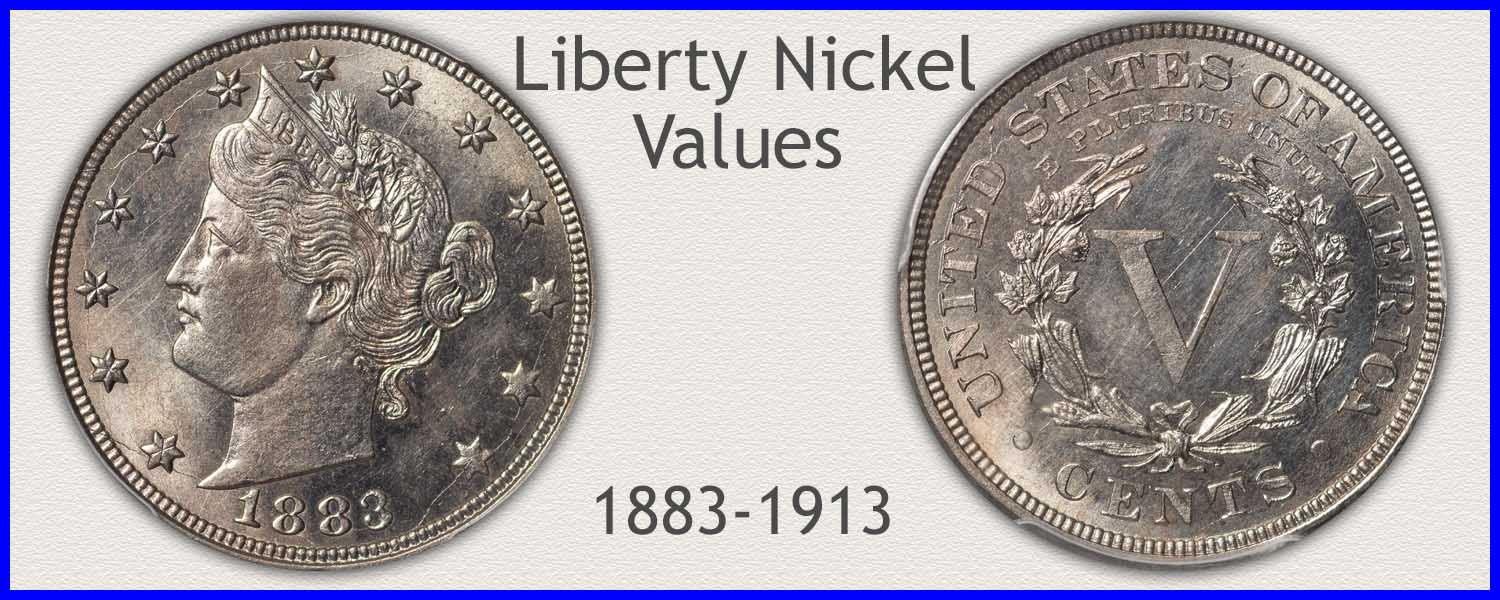Coin Values Moving with Precious Metals: Up-Dated 4/21/2025: Gold $3380 | Silver $32.89
1890 Nickel Value
The chart shows strong fundamentals determine 1890 nickel value. It is crucial to evaluate levels of wear and the overall state of preservation. Recognizing a collectible grade coin is a strong factor in value. Collectors rate the value of 1890 Liberty nickels based on their visual appeal.
Judge key features using a step-by-step process detailed below. Completing all the steps finds a narrow range on the value chart.
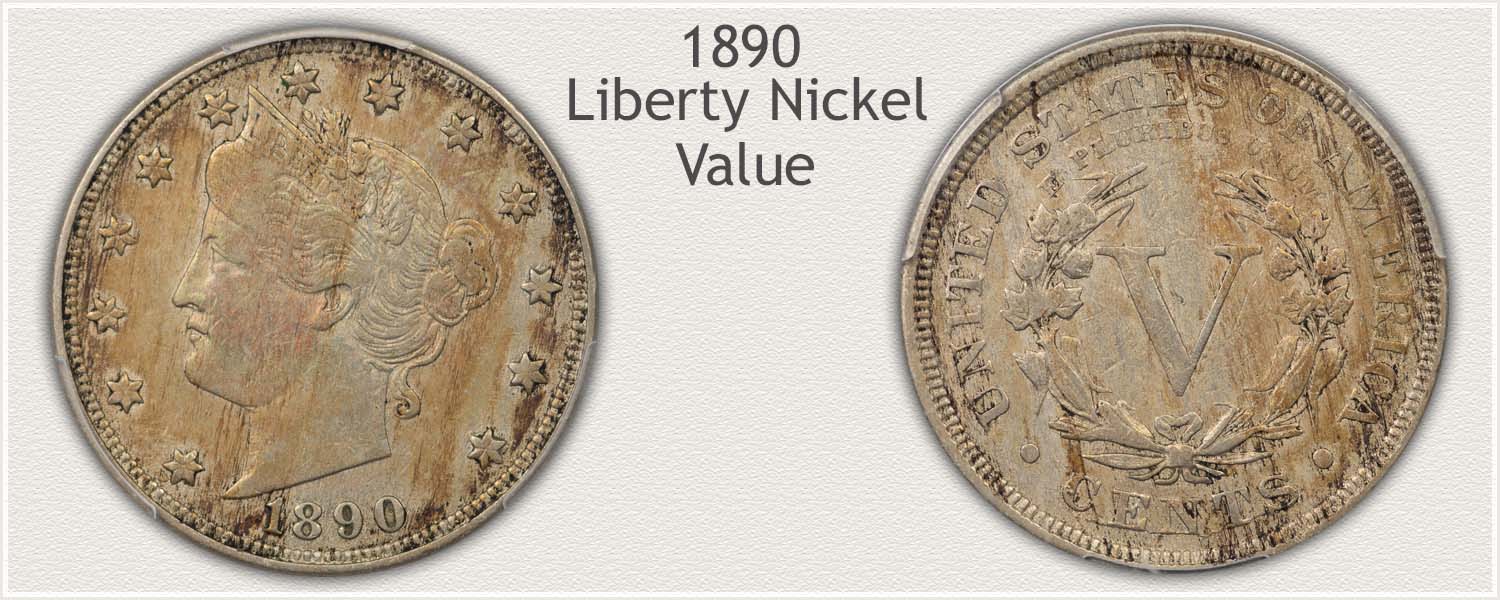
Steps Leading to Value:
- Step 1: Date Identified - A scarce coin from the popular Liberty Nickel series. Confirm the year 1890 nickel, an in-demand coin.
- Step 2: Grading Condition - Images and descriptions judge the preservation, quality and grade of Shield nickels.
- Step 3: Special Qualities - The collectible market recognizes fundamental rarity and historical value. Two important factors determine how much these nickels are worth.
| 1890 Nickel Value | ||||
|---|---|---|---|---|
| Condition of Coin | ||||
| Date | Good | Fine | Extremely Fine |
Mint State |
| Liberty Nickel Value Updated | 2024 | |||
| 1890 | $7.37 | $21 | $47 | $97 |
A narrow range of Wholesale values is listed on the chart. Using these as a guide is a conservative approach, taking into account variances in the market. Dealer's demands and overall eye appeal contribute to a final worth.
Step 1: The Specific Date is How to Value These Nickels
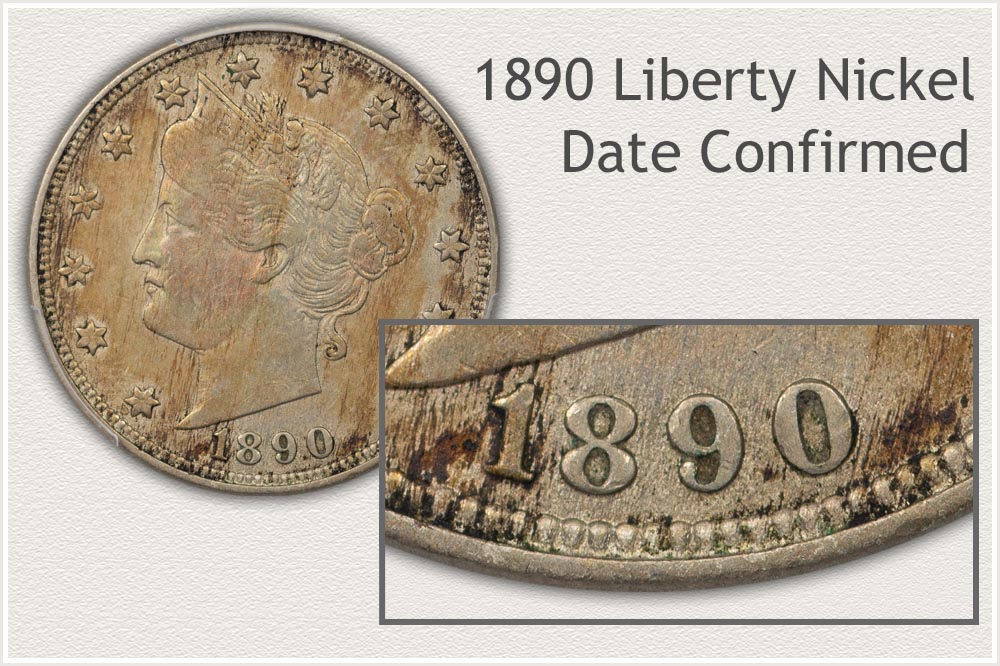
1890 nickels are within the early era of the Liberty series. These initial years have all developed strong premiums. These are coins with a reputation of scarcity in all states of preservation. Demand in "collector" grades, is strong for coins having eye appeal along with wear. The Philadelphia mint recorded a production of 16.2 million released into circulation. Today's demand by collectors and their value indicates few were saved over the years.
With the potential of high values, a second look at the date is needed. Individual dates are very specific to the collecting hobbyist and value chart listings.
Step 2: | Examine Surface Condition and Determine Grade
Visible Details Highlight Premium Quality
Grading condition narrows 1890 nickel value to a specific range on the chart above. One of the key features collectors and dealers first identify is the visibility of "Liberty" across the headband. Within the Liberty nickel series, and especially in the early years, a visible "Liberty" immediately places the coin in premium collector quality.
Liberty's portrait and headband wear in recognizable patterns. Examine the following grading images. Stages of wear illustrated, represent how they relate to different grades. Examine each element as highlighted in the descriptions, recognizable details confirm a grade.
Mint State Grade
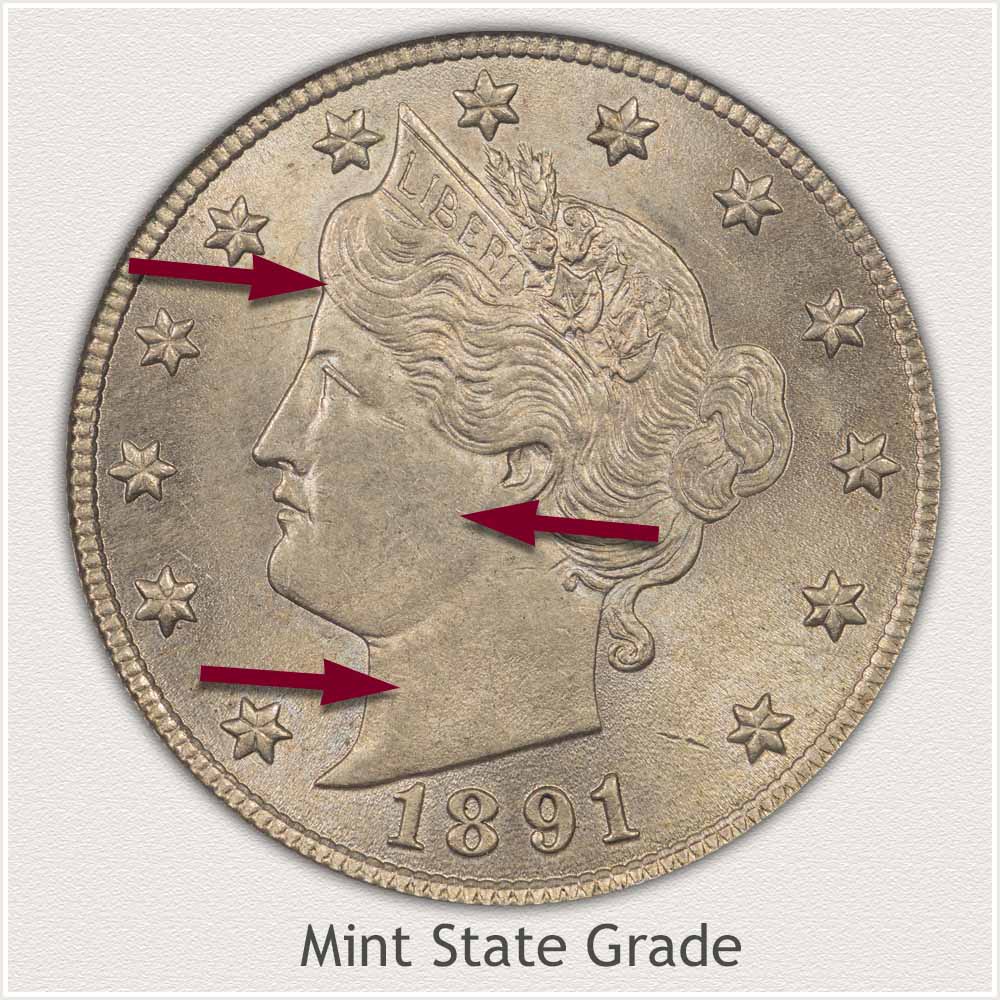
Mint State: Only coins with no visible signs of wear make it into the coveted Mint State grade. The "no wear" characteristic is essential for defining and determining this superior condition. This old nickel design features a very detailed portrait of Liberty. A first step in judging the absence of wear is a visual inspection of the high relief areas.
Starting with Liberty's face and neck, an undisturbed metal surface remains. These areas have a texture that reflects light as luster. A worn surface on these nickels no longer has the delicate minting texture. Instead, wear has a smooth surface and a muted gray hue. Of note, exposed areas of her cheek and neck often become toned a light tan. Look beneath the toning to detect any smoothing of the metal indicating wear. Recognizing surface similarities and differences help in judging wear. Compare the metal's texture on upper and lower relief sections along the neck line.
Examine the fine strands of hair along her forehead next. The highest points of hair are completely rounded. No evidence of flattered or worn metal is visible. Each strand on her forehead and at the top of her head remains covered in a delicate luster. Confirm luster "beneath" any toning by tilting the coin under a light. This luster appears as brightness that moves with the light.
Extremely Fine Grade
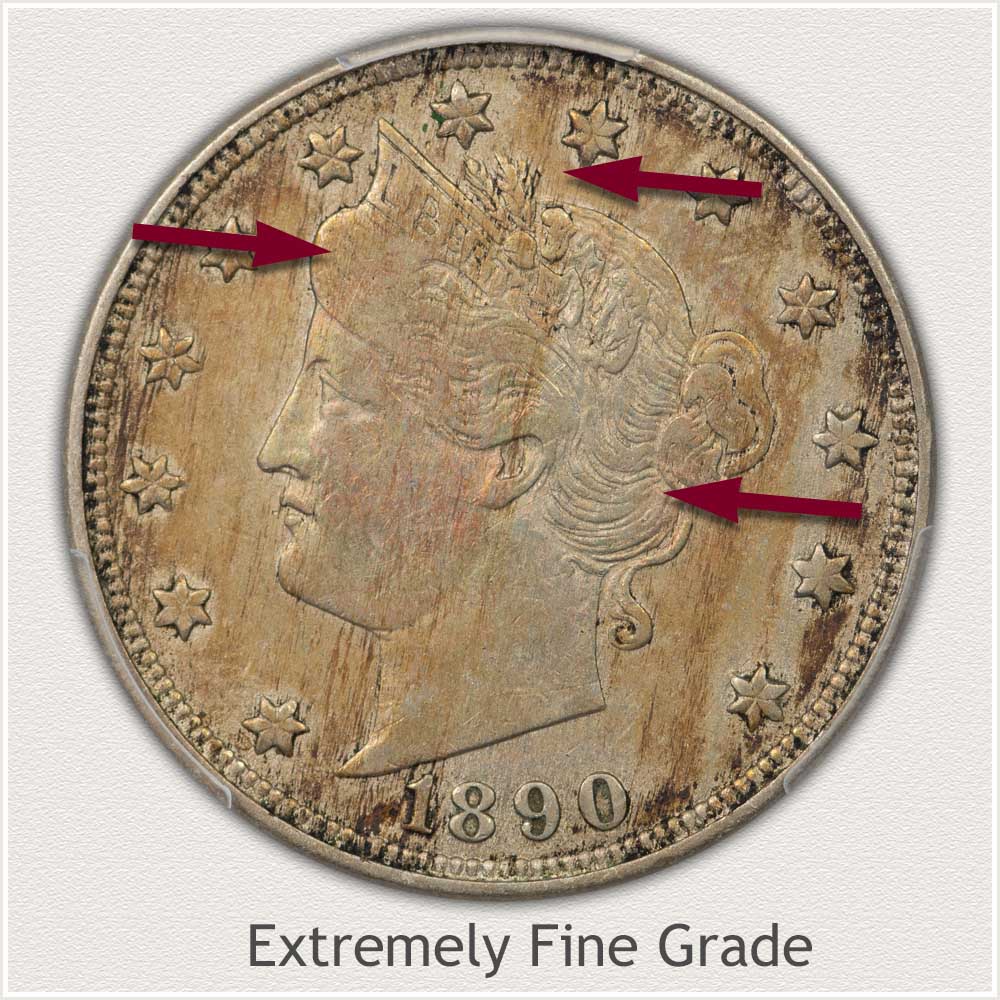
Extremely Fine: When viewed overall, circulation wear is just beginning to reduce the height of fine design details in Extremely Fine grade. An important quality of this condition is the limited amount of wear in only small areas. When examined closely, this light wear is then identified and measured.
Locate the two wheat grain sprays directly above Liberty's headband. These are an excellent indicator to judge if the amount of wear is light. When compared one to the other, the one closest to the headband exhibits more detail than the other. There is only a very slight amount of wear visible, as evidenced by the abundant detail in both the wheat sprays. Additionally, there remains a full separation of the two. Next, there is a noticeable loss of hair detail in the area just above Liberty's eye. This flattening and blending of the hair strands only occur in this small area. The majority of individual hair strands within the waves are still clearly visible.
The nickel's overall color is fading to a soft gray and losing its luster and brilliance. Also used to identify only light wear is the sharp detail of both her ear and the hair just behind. Having crisp details is a requirement of a high-quality collectible Liberty nickel.
Fine Grade
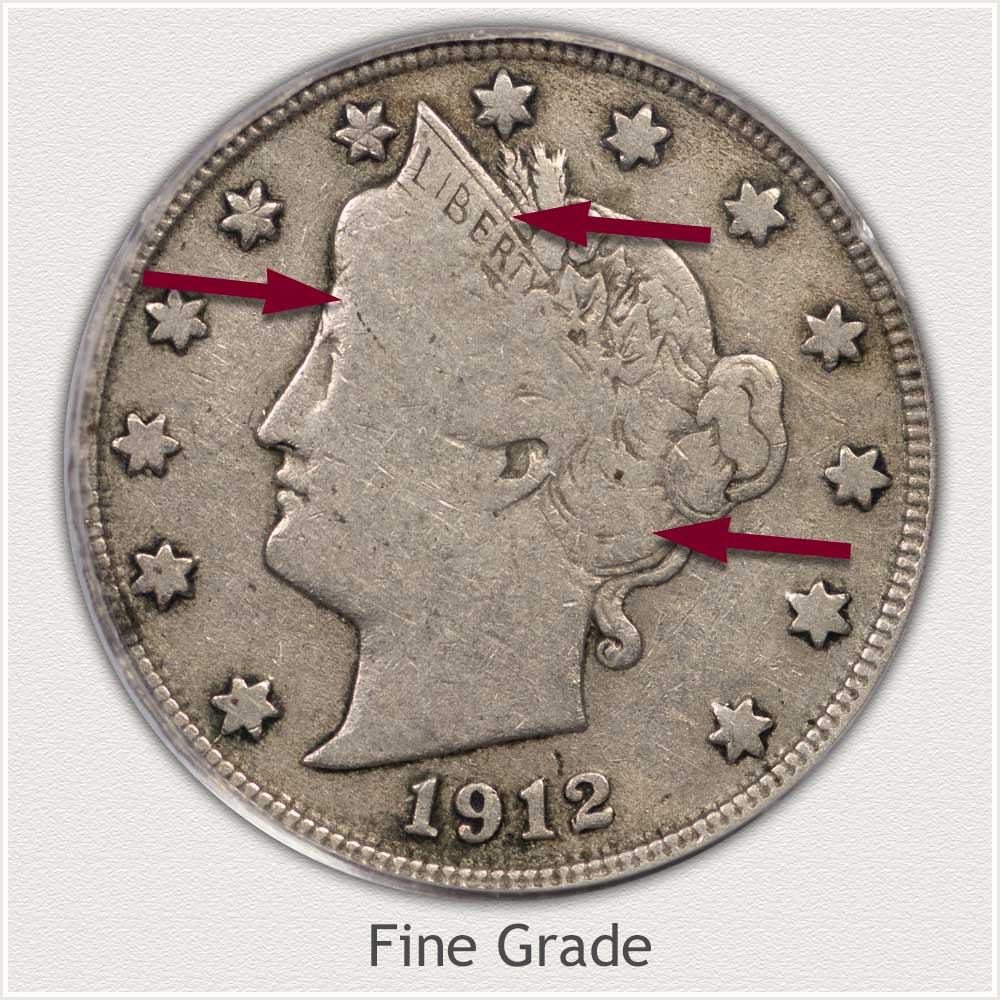
Fine Grade: With visible wear covering the surface, only deeply recessed details remain on a Fine grade Liberty nickel. This grade coin exhibit significant worn areas. Many of the small details are missing from the higher relief design areas. Fine grade Liberty nickels feature moderate wear with no major details missing.
As an example of moderate wear, Liberty's hair appears smooth over her forehead. Only small lines of hair remain visible towards the back of her head. Wear and the amount of missing metal has all but removed the defining hair line separating the forehead. Missing this detail of a hair line feature is important when placing the coin into the Fine grade. A lack of hair detail above her eye and extending almost to her ear defines moderate wear.
A legible "LIBERTY" on the headband is a requirement to reach the Fine grade. With the letter "I" frequently the most faded, a visible, complete letter "I" is a plus that adds value to the coin.
Good Grade
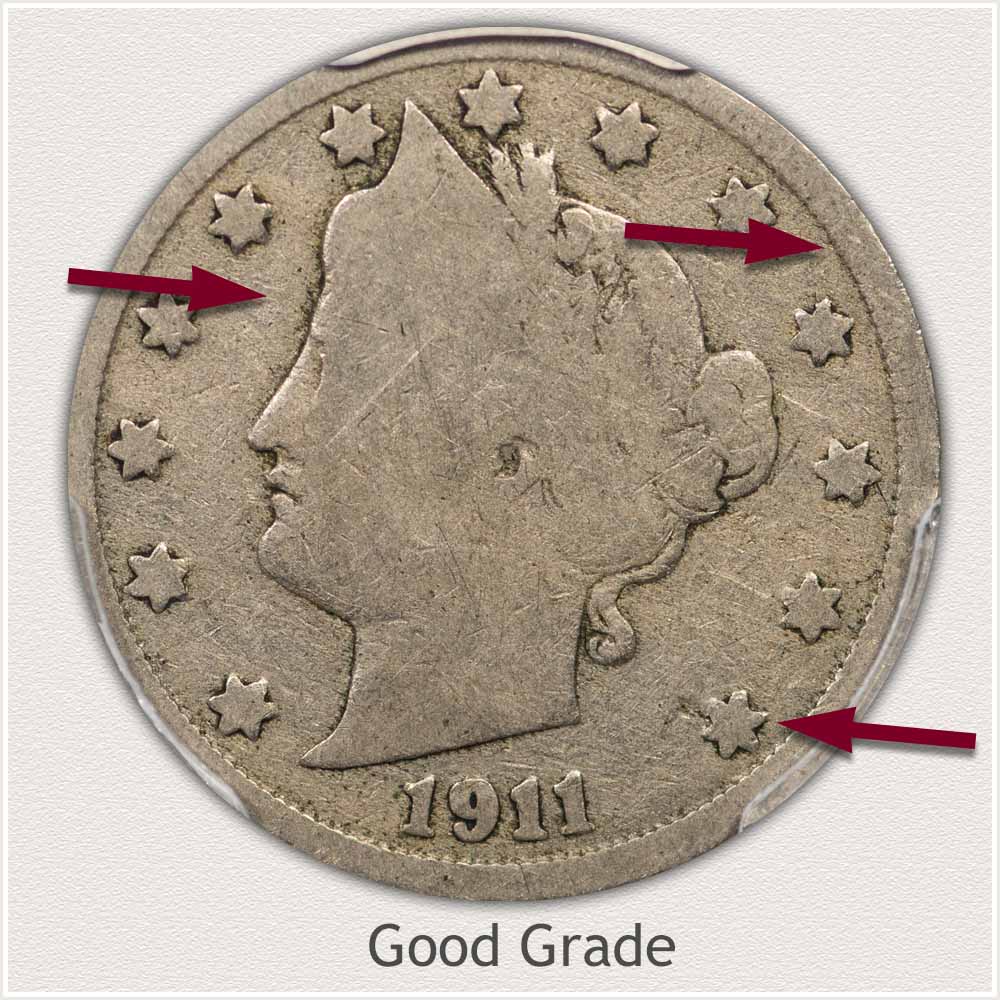
Good Grade: Liberty's portrait on the example has lost most of its original detail due to extensive wear. Defining the Good grade is the absence of minor design elements. However, the coin retains a complete outline of Liberty. A complete outline of the portrait is essential to earning the Good grade for a Liberty nickel.
The importance of eye appeal has now increased. Preventing the coin from looking "worn out" are the full stars, a strong date, and a complete inner rim. Even in its heavily worn state, a Liberty nickel of Good quality still has collector value. A second inspection reveals no major dents along the outer edge. A coin without damage adds to its aesthetic value.
How to Video: Grading Liberty Nickels
Viewing the video covers grading the condition of Liberty nickels in greater detail. Descriptions point to key elements of a narrow grade range on both the obverse and reverse.
Grading Liberty Nickels | How to Video and Descriptions
Step 3: | Special Qualities | Nickels are a Difficult Coin to Mint
How to Spot a Typical Problem the Mint Faced Producing Quality Nickels
Liberty nickels, including these 1890 nickels, were a challenge for the Philadelphia mint to strike in high quality. Nickel is the hardest of the metals in U.S. coinage. The mint had a long experience with Gold the softest, and then silver and copper coinage. The 5-Cent Nickels, an alloy of 25% nickel and 75% copper was first used in the Shield design series beginning in 1866. By 1867, the U.S. Mint reported their difficulty in using this nickel alloy in production. The following quote from the mint report sums up the problem.
"Owing mainly to the immense amount of the lower coinage, and the somewhat refractory nature of the nickel-copper alloys used in pursuance of law, the machinery had become much worn, and unsuitable for the proper execution of the work. This is strikingly shown by a single fact, that in three months' operations, over eleven hundred working dies were used and broken. "
Working dies, as referred to in the quote, are used to impress the design of the coin into the metal. One of the first signs of stress and deterioration is the development of surface cracks in the die. These small die cracks eventually deepen, lengthen, and widen, leading to die failure.
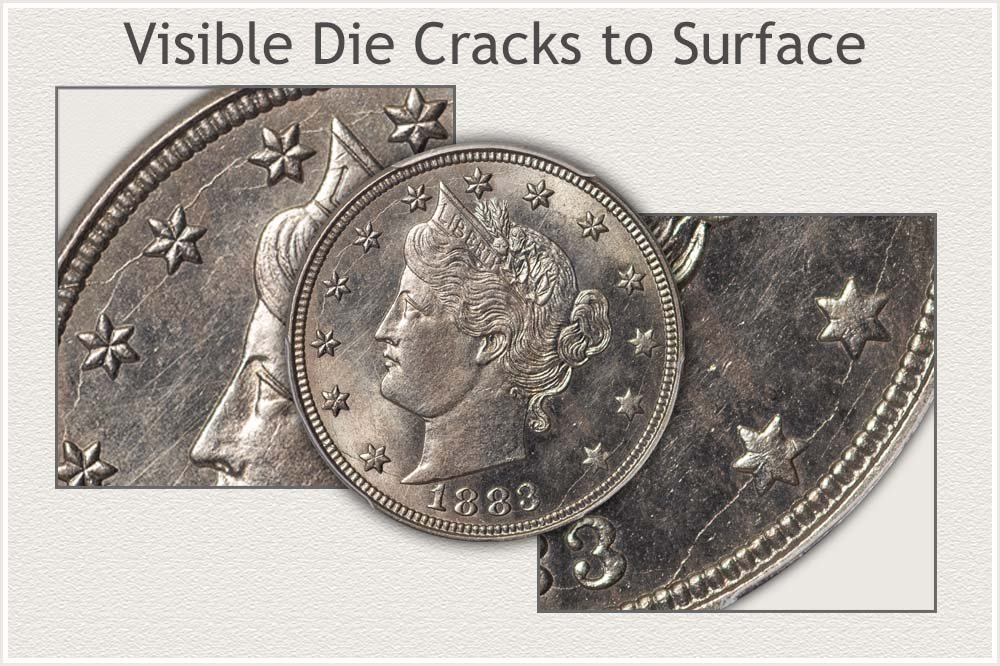 Die Cracks Visible on a Liberty Nickel
Die Cracks Visible on a Liberty Nickel
Die cracks are distinguished as raised lines. This is in contrast to scratches, which are lines impressed into the surface. Looking at the image, notice small raise lines located between letters. Small areas between the design are typical stress points of the strike. By the 1890's and experience with the alloy, the mint began to show improvement in quality. One of their solutions was limit the total number of nickels struck by each die. In the Liberty series, dies used for nickels struck far fewer coins than dies striking dimes and cents. Retiring nickel coinage dies sooner maintained top quality of the coins.
Die Life Span: Coins Struck per Die: Philadelphia Obverse/Reverse Dies
as Reported in 1912
- Dimes: 203,941/208281
- 5-Cent Nickels: 166,405/166/405
- 1-Cent Bronze: 345,436/355,886
Controlling and limiting die use helped when striking nickels. The mint started to see results in overall quality.
When noticing small raised lines on these old nickels, realize they are indicating a stressed die. Many hobbyists except these. Others specifically look for coins without. Only when large areas of the design are disrupted caused by breakage of the die, is added attention given as an error coin.
Small die cracks on nickels, are an early stage in the mint's efforts to solve the situation. Eventually, these imperfections became less and less over time. Today they are a visual insight to the beginnings of U.S. nickel coinage.
References
U.S. Mint. 1891 U.S. Mint Annual Report
https://nnp.wustl.edu/library/book/512060
US Mint. 1867 US Mint Annual Report
https://nnp.wustl.edu/library/book/516168
U.S. Mint. 1912 U.S. Mint Annual Report
https://nnp.wustl.edu/library/book/324
U.S. Mint. Catalogue of Coins of the United States.
https://nnp.wustl.edu/library/book/554591
Coin Values | CoinStudy Articles
Date by Date
In Depth Liberty Nickel Values
1883 to 1912
The Value of V Nickels | Common to Very Rare Liberty Nickels
Review the value chart listing all dates. As a series Liberty nickels show a gain in popularity causing all dates and mints to rise in value. The Liberty design series began in 1883 and any date in the early era is a premium coin an all grades.
Popular Coin Series | Liberty Nickels
Demand and popularity are important to understanding market values. Ranking of major coin series shows nickels just after dimes in popularity.
Coin Value Guide | How to Value a Coin Collection
Liberty nickels are one of many different series of classic U.S. coinage. Determine how to value all these different series in a step-by-step method. Begin here with the guide and proceed through an organized method. Judge all key elements and complete an assessment of your holdings.
Selling Coins | A Defined Process
During the selling process, assemble the needed key information. Review the methods used by the hobbyist in the coin market. Next, determine an estimate of value and reference the listing of dealers to contact.
★Coin Values Discovery finds 1890 Nickel Value and...
An excellent index covering U.S. coin values. Start the step-by-step process to recognize the correct coin series leading to value charts, grading condition, and any special qualities. A box of old coins has potential.
